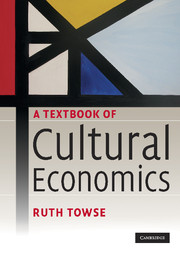Book contents
- Frontmatter
- Contents
- List of figures
- List of tables
- List of boxes
- List of abbreviations
- Preface
- Part I General issues in cultural economics
- Introduction
- 1 Introduction to cultural economics
- 2 Economic profile of the cultural sector
- 3 Markets for cultural goods and services
- 4 Economic organisation of the creative industries
- 5 Production, costs and supply of cultural goods
- 6 Consumption of cultural goods and services
- 7 Welfare economics and public finance
- Part II The ‘traditional’ economics of the arts and heritage
- Part III Artists' labour markets and copyright
- Part IV The creative industries
- Part V Conclusion and exercises and problems
- References
- Index
1 - Introduction to cultural economics
- Frontmatter
- Contents
- List of figures
- List of tables
- List of boxes
- List of abbreviations
- Preface
- Part I General issues in cultural economics
- Introduction
- 1 Introduction to cultural economics
- 2 Economic profile of the cultural sector
- 3 Markets for cultural goods and services
- 4 Economic organisation of the creative industries
- 5 Production, costs and supply of cultural goods
- 6 Consumption of cultural goods and services
- 7 Welfare economics and public finance
- Part II The ‘traditional’ economics of the arts and heritage
- Part III Artists' labour markets and copyright
- Part IV The creative industries
- Part V Conclusion and exercises and problems
- References
- Index
Summary
This chapter introduces cultural economics and explains how cultural economists set about analysing the cultural sector – the arts (performing arts, visual arts and literature), heritage (museums and built heritage) and the creative industries (the music, publishing and film industries, broadcasting, and so on). It provides a guide to the terms used throughout the book and prepares the way for the concepts and subject matter of subsequent chapters.
What is cultural economics about?
Ten questions we ask and answer
What determines the price of a pop concert or an opera? Why is there a star system in the arts? Why are many artists poor? Why does Hollywood dominate the film industry? Can we predict the success of a film or record? Does illegal downloading damage the record industry? Does free entry to museums bring in more visitors? Why does the government support the arts? How much are we willing to pay to protect the cultural heritage? What are the reasons for public service broadcasting? These are ten of the many questions that cultural economists have asked and tried to answer. This book asks and answers them through the lens of cultural economics.
Cultural economics
Cultural economics studies these (and other) questions using economic analysis. As a discipline, economics uses theory – economic principles – to analyse problems and it also uses empirical evidence – the use of statistical data – to try to answer them.
- Type
- Chapter
- Information
- A Textbook of Cultural Economics , pp. 5 - 25Publisher: Cambridge University PressPrint publication year: 2010



